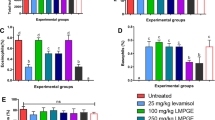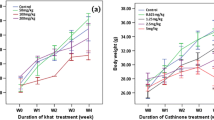Abstract
Euphorbia hirta L. (Euphorbiaceae) (E. hirta) is a tree locally used as a traditional medicine in Africa and Australia to treat numerous diseases such as hypertension, respiratory ailments, tumors, wounds, antipyretic, anti-inflammatory activities, etc. Therefore, we undertook to investigate their immunomodulatory effect on T lymphocytes (CD3+, CD4+ and CD8+ receptors) and Th1 cytokines (IL-2, TNF-α, IFN-γ) in a dose-dependent manner. E. hirta ethanol extract at 25, 50, 100 and 200 mg/kg doses was given orally for 7 days from the day of immunization. E. hirta maximum inhibition at 100 and 200 mg/kg p.o. was found to significantly block the production of the cell-mediated immune response, (CD3+, CD4+ and CD8+ receptors) and (IL-2, TNF-α, IFN-γ) and also prolongs graft rejection. E. hirta also showed a decrease of delayed hypersensitivity (DTH) response and dose-related decrease in the primary antibody response, respectively. Based on the data, it can be suggested that E. hirta is a potent and non-toxic immunosuppressor, which can be further explored for the development of potent immunosuppressor.








Similar content being viewed by others
References
Archana Jatawa S, Paul R, Tiwari A (2011) Indian medicinal plants: a rich source of natural immunomodulator. Int J Pharmacol 7(2):198–205
Billingham RE, Medawar PB (1951) The technique of free skin grafting in mammals. J Exp Biol 28:385–402
Bourgeols C, Corinne T (2003) CD4 T cells are required for CD8 T cell memory generation. Eur J Immunol 33:3225–3231
Chellaiah M, Muniappan A, Nagappan R, Savarimuthu I (2006) Medicinal plants used by traditional healers in Kancheepuram district of Tamil Nadu, India. J Ethnobiol Ethnomed 7:2–43
Doherty NS (1981) Selective effect of immunosuppressive agents against the delayed hypersensitivity response and humoral response to sheep red blood cells in mice. Agents Actions 11:237–242
Eldahshan OA (2011) Isolation and structure elucidation of phenolic compounds of carob leaves grown in Egypt. Curr Res J Biol Sci 3(1):52–55
Gautam R, Saklani A, Jachak SM (2007) Indian medicinal plants as a source of antimycobacterial agents. J Ethnopharmacol 110:200–234
Khan SF, Malik Suri KA, Singh J (2009) Molecular insight into the immune up-regulatory properties of the leaf extract of Ashwagandha and identification of Th1 immunostimulatory chemical entity. Vaccine 27:6080–6087
Kidd P (2003) Th1/Th2 Balance: the hypothesis, its limitations, and implications for health and disease. Altern Med Rev 8(3):223–246
Lee KH, Chen YS, Judson JP, Chakravarthi S, Sim YM, Er HM (2008) The effect of water extracts of Euphorbia hirta on cartilage degeneration in arthritic rats. Malays J Pathol 30(2):95–102
Liu Y, Murakami N, Ji H, Abreu P, Zhang S (2007) Antimalarial flavonol glycosides from Euphorbia hirta. Pharm Biol 45:278–281
Mathur A, Verma SK, Purohit R, Singh SK, Mathur D, Prasad GBKS, Dua VK (2010) Pharmacological investigation of Bacopa monnieri on the basis of antioxidant, antimicrobial and anti-inflammatory properties. J Chem Pharma Res 2:191–198
Mathur A, Verma SK, Singh SK, Mathur D, Prasad GBKS, Dua VK (2011) Investigation of anti-inflammatory properties of Swertia chirayta and Gloriosa superb. Recent Res Sci Tech 3:40–43
Nelson DS, Mildenhall P (1967) Studies on cytophilic antibodies. The production by mice of macrophage cytophilic antibodies to sheep erythrocytes: relationship to the production of other antibodies and development of delayed-type hypersensitivity. Aust J Exp Biol Med Sci 45:113–130
Oberholzer A, Oberholzer C, Moldawer L (2000) Cytokine signaling-regulation of the immune response in normal and critically ill states. Crit Care Med 28:N3–N12
OECD (1996) Guidelines for testing of chemicals. Organization for economic cooperation and development guideline 423, acute oral toxicity-acute toxic class method
Owolabi J, Omogbai EKI, Obasuyi O (2007) Antifungal and antibacterial activities of the ethanolic and aqueous extract of Kigelia africana (Bignoniaceae) stem bark. Afr J Biotechnol 6(14):882–885
Salem ML (2005) Immunomodulatory and therapeutic properties of the Nigella sativa L. seed. I Immunopharmacol 5:1749–1770
Sharma NK, Dey S, Prasad R (2007) In vitro antioxidant potential evaluation of Euphorbia hirta L. Pharmacologyonline 1:91–98
Shih MF, Cheng YD, Shen CR, Cherng JY (2010) A molecular pharmacology study into the anti-inflammatory actions of Euphorbia hirta L. on the LPS-induced RAW 264.7 cells through selective iNOS protein inhibition. J Nat Med 64(3):330–335
Singh GB, Srimal RC, Nityanand S, Dhawan BN (1978) Pharmacological studies on 3-p-fluorebenzoyl-propyl)-2,3,4,5,6-hexahydro-1-(H)-pyrazino-(1,2-a)-quinoline hydrochloride (compound 69/183). Arzneimittelforschung 28:1403–1406
Singh GD, Kaiser P, Youssouf MS, Singh S, Khajuria A, Koul A, Bani S, Kapahi BK, Satti NK, Suri KA, Johri RK (2006) Inhibition of early and late phase allergic reactions by Euphorbia hirta L. Phytother Res 20(4):316–321
Stephens R, Eisenbarth SC, Chaplin DD (2002) T helper type 1 cells in asthma: friend or foe. Curr Opin Allergy Clin Immunol 2:31–37
Subramanian SP, Bhuvaneshwari S, Prasath GS (2011) Antidiabetic and antioxidant potentials of Euphorbia hirta leaves extract studied in streptozotocin-induced experimental diabetes in rats. Gen Physiol Biophys 30(3):278–285
Suna H, Qin XF, Pan YJ (2005) In vitro and in vivo immunosuppressive activity of Spica prunellae ethanol extract on the immune responses in mice. J Ethnopharmacol 101:31–36
Suresh K, Deepa P, Harisaranraj R, Vaira Achudhan V (2008) Antimicrobial and phytochemical investigation of the leaves of Carica papaya L., Cynodon dactylon (L.) Pers., Euphorbia hirta L., Melia azedarach L. and Psidium guajava L. Ethnobot Leafl 12:1184–1189
Szabo SJ, Dighe AS, Gubler U, Murphy KM (1997) Regulation of the interleukin (IL)-12R β2 subunit expression in developing T helper 1 (Th1) and Th2 cells. J Exp Med 185:817–824
The Wealth of India (Raw material), New Delhi. Council of Industrial and Scientific Research, (2005). Vol 3
Tona L, Kambu K, Ngimbi N, Mesia K, Penge O, Lusakibanza M (2000) Antiamoebic and spasmolytic activities of extracts from some antidiarrhoeal traditional preparations used in Kinshasa and Congo. Phytomedicine 7:31–38
Whelan M, Whelan J, Russell N, Dalgleish A (2003) Cancer immunotherapy: an embarrassment of riches. Drug Discov Today 8:253–258
Wieland HA, Martin M, Bernhard JK, Rudolphi KA (2005) Steoarthritis an untreatable disease. Nat Rev Drug Discov 4:331–344
Wong SHY (2003) Therapeutic drug monitoring for immunosuppressants. Clin Chim Acta 313:241–253
Acknowledgments
The authors are grateful for the Research Center of Pharmacy, King Saud University, Riyadh, Saudi Arabia.
Conflict of interest
The authors declare that there is no conflict of interest.
Author information
Authors and Affiliations
Corresponding author
Rights and permissions
About this article
Cite this article
Ahmad, S.F., Khan, B., Bani, S. et al. Immunosuppressive effects of Euphorbia hirta in experimental animals. Inflammopharmacol 21, 161–168 (2013). https://doi.org/10.1007/s10787-012-0144-6
Received:
Accepted:
Published:
Issue Date:
DOI: https://doi.org/10.1007/s10787-012-0144-6




